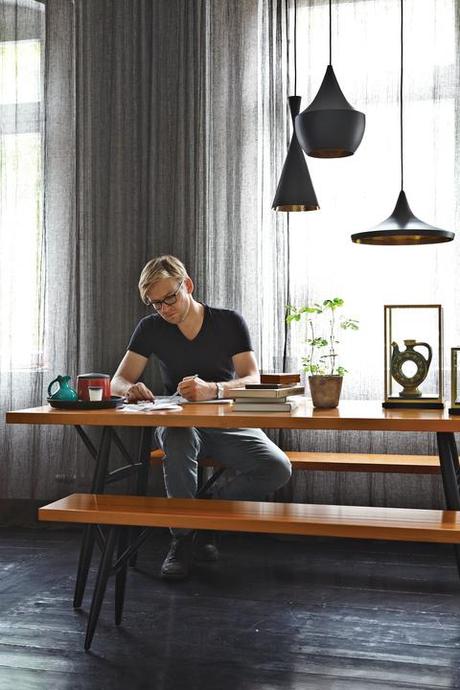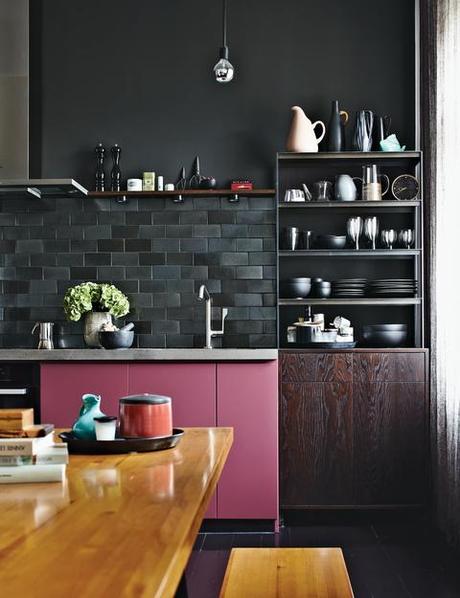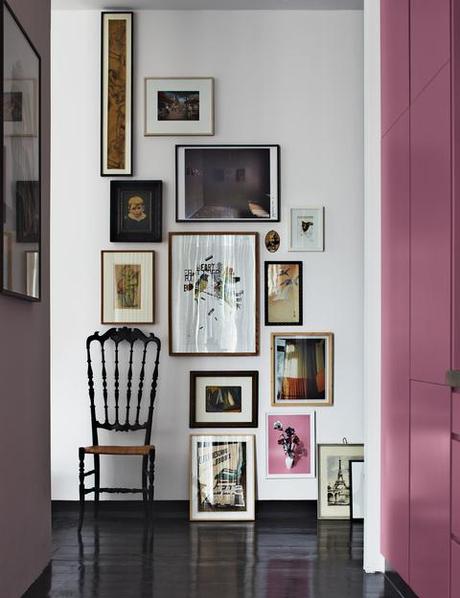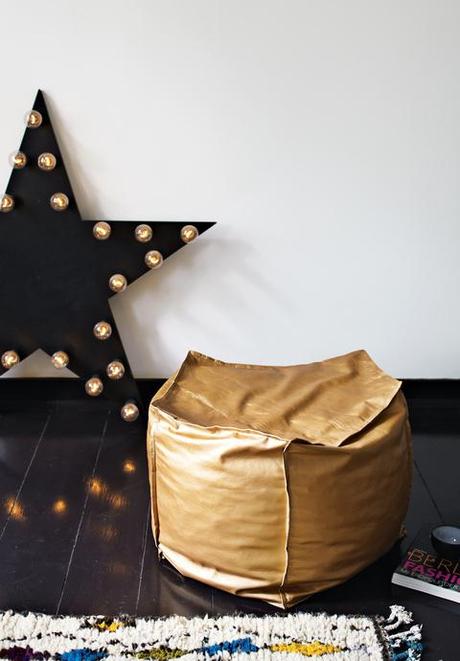
The old wood floors throughout the open-plan space are painted a dark eggplant. The vintage PP19 armchair is by Hans J. Wegner for PP Møbler. The painting above it is by Ruben Toledo, a friend of Peter Fehrentz, the resident. A trio of Tom Dixon lights hangs over the Pirkka dining table, with bench seating by Ilmari Tapiovaara for Artek. The Berber rug is from Morocco, purchased from the Paris shop Caravane.
Until recently, Peter Fehrentz lived full-time in Hamburg, Germany. But he longed for a pied-à-terre in Berlin, a city he describes as “lively, complex, multicultural, and, for me, a source of inspiration.” His brother and many friends lived there, and he frequently visited. Finally, in 2009, he took the plunge and purchased a flat in Schöneberg, an up-and-coming neighborhood in west Berlin known for its art galleries, cafes, and fashion boutiques.
Slideshow
He cast the concrete base of the table lamp. The 1950s teak coffee table is vintage. Sheer gray curtains by Ulf Moritz for Sahco add to the apartment’s moody atmosphere.
In this area, apartments seldom come on the market—so when this one did, he pounced, despite the fact that it held little aesthetic appeal. The fourth-floor unit had no direct sunlight and no balcony; it consisted of a warren of tiny rooms; and it measured just 646 square feet. The bathroom was less than three feet wide, and the only way to get into the shower was to climb over the toilet. Located in the side wing of a turn-of-the-20th-century building, the unit lacked plaster ornamentation and architectural detailing—indicating its past as servants’ quarters. “Normally, you wouldn’t invest much money and time into such a humble place,” says Fehrentz. But he saw the potential for a stylish, refined, and sophisticated place to show his work to clients.Fortunately, he had the design chops to execute this vision. In addition to his work as an interior designer and photographer, he is also a stylist and set designer, creating artificial rooms for editorial and advertising photo shoots, and building props, lighting, and furnishings from scratch. Thanks to his professional experience and his hands-on approach, “I could see immediately what walls should stay and what should be ripped out and changed,” he says. “I had a fantasy about how to transform it into a very personal place.”
Slideshow
He created the star as a prop for a photo shoot. The kitchen cabinets benefit from a pop of rosy color, a custom hue. Fehrentz designed the steel-and-wood storage unit.
First he hired local builders to rip out every interior wall they could, creating an open-plan kitchen, living room, and dining area that feels gracious despite its compact size. Seeking a change from his airy, white Hamburg home, Fehrentz chose a dark, elegant palette peppered with a few flashes of color for his Berlin flat. He painted the old wood floors a very dark eggplant that reads as a warm black. The bedroom is a rich blue-green; the living and dining area is white and is anchored by a petrol-blue sofa and a gray armchair. Gauzy gray curtains, hanging from curtain rods inset in the ceiling, screen all four windows and admit a diffused daylight. Due to the northern orientation and lack of views, “I decided to conceive the Berlin flat as a cocoon—a cozy, capsule-like retreat within the lively metropolis,” says Fehrentz. “The northern light, combined with dark colors, creates an artistic, almost dramatic atmosphere, reminiscent of the Flemish Old Masters.” This impression is compounded by details like the baroque landscape scene printed on the canvas-covered doors of the wardrobe Fehrentz custom-designed for the bedroom and by his choice of luxurious materials, such as the verde bamboo granite lining the tiny bathroom and the wenge-stained oak in the kitchen. Slideshow
Fehrentz displays his collections of art and objects throughout his apartment. The chair is a vintage Chiavari from the ’60s.
Naturally, the size of the flat also affected Fehrentz’s furniture choices. “It is quite a small space, so I made sure that the furniture wasn’t too big and could be used for a variety of purposes,” he explains. He bought a mid-century Pirkka wooden table and benches designed by Ilmari Tapiovaara for Artek because “benches don’t take up much space,” says Fehrentz. “You don’t want to put too much furniture in a small place—two benches are better than six armchairs.” Two other pieces anchor the living space (Fehrentz calls them the “heroes” in the room): an iconic PP19 armchair by Hans J. Wegner, purchased affordably from an online auction, and a mohair velvet sofa, designed by Fehrentz to save space (the backrests are mounted on the wall) and to double as a guest bed. The latter is Fehrentz’s favorite piece among his many DIY contributions, which also include a steel-and-wood storage tower in the kitchen and a copper-colored leather pouffe in the living room. Slideshow
The copper-colored leather pouffe is one of 48 DIY projects featured in Fehrentz’s book, Made by Yourself. The English edition will be published in 2014.
Finishing the apartment took about three years, during which time he pondered color choices, tried out design ideas, and arranged and rearranged furniture. But once he hit on the right solutions—a reddish pink for the kitchen cabinets, inspired by the color on a matchbox strike zone; a floor-to-ceiling mirrored door between the bedroom and bathroom—he never looked back. Of the sofa, which he placed in the corner of the apartment with the widest view, he says: “Once I came up with the finishing touches, I knew immediately it was right and never questioned it again. It’s in the right place, and it’s perfect.”In addition to being an ideal weekend getaway, Fehrentz’s Berlin apartment also serves as a showroom for potential clients—a three-dimensional showcase of his design sensibility. “I often have meetings with new clients here, and I’ve also given people the keys so they can spend a weekend in the flat while I’m away,” he says. “People usually think the space will be too dark. But after they’ve experienced it in person, they really come around.”
